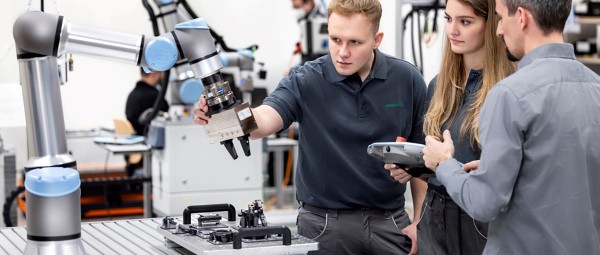Cutting cobot cycle times
A new torque sensor system for cobots – integrated into a precision strain wave gear – enhances the performance of cobots and lightweight robots, as well as shortening cycle times. This represents a major advancement in breaking down the barriers to the widespread use of robots in industrial automation, says Ralf Moseberg, Head of the Industrial Automation Business Unit at Schaeffler.
Of all the circular gear types, the strain wave gear stands out due to its elastic element, the flex spline. Successfully used in the early 1970s during the Apollo space missions in the wheel drives of the lunar roving vehicles, it was developed further for parabolic antenna and solar panel tracking, as well as aviation and medical technology.
Strain wave gears have been used for decades as precision servo gearboxes in industrial automation. Today, they are also the preferred gear types for small articulated robots with payloads of up to around 20 kg. The outstanding characteristics of strain wave gears include high positioning accuracy, high repeatability, zero backlash, compact design and low mass

The number of strain wave gear manufacturers today is modest, primarily due to the numerous niche applications and challenging gear tooth technology.

The key to increased cobot sales
There is widespread agreement in the industry that sales of collaborative robots (cobots) could skyrocket if only a few technical problems were solved. Starting with how to achieve higher speeds/accelerations and therefore greater productivity of cobots in autonomous operation. There is also the demand for sensitivity in collaborative mode, with all of this at an attractive cost. Cobots with both of these properties could be used flexibly, for example, by working collaboratively during the day and autonomously at night. This would result in significant increases in productivity and a faster payback.
For cobots that must execute processes with sensitivity, force control and for smooth teaching processes, there is no alternative other than to use sensor systems for determining external forces and moments. The most popular products are sensor modules, i.e. sensors that are offered as separate components for cobots. However, they require additional installation space and must be integrated into the cobot design.
Cobots are clearly disadvantaged due to their slender design, which results in a higher elasticity compared with that of industrial robots. The thin cobot structure vibrates noticeably with high accelerations – particularly when positioning with maximum braking. What is gained in terms of a shorter cycle time through high speeds and accelerations is lost through the longer time it takes for the vibrations to settle down during positioning.
The natural frequency of a cobot is mainly influenced by the tilting rigidity of the joint bearings / gear unit main bearings, as well as the torsional stiffness of the gears (and the torsional stiffness of the torque sensors).

With external torque sensors, the torsional stiffness of a joint can drop to 25% due to the additional elasticity introduced, however with the concept developed by Schaeffler, the torsional stiffness of the joint is completely retained.

Characteristics of internal torque sensors
Schaeffler is highly experienced in the development, application and mass production of integrated torque sensors. Its Sensotect sensor technology, for example, is used successfully in wind turbines and in the automotive industry. The functionality is realised through a sub-micrometer-thick, strain-sensitive metal PVD coating. The component itself becomes the sensor and the sensor becomes the component. For application in robotics, the flex spline of the precision strain wave gear is used because it lies directly in the path of power flow. No additional installation space, adhesives or transfer polymers are required.
As a further element of the overall solution, Schaeffler developed the XZU double-row angular contact needle roller bearings for the RT precision strain wave gear series. They increase the rigidity of the cobot structure transversely to the rotary axes. With XZU bearings rather than the usual crossed roller bearings in all of the joints of a cobot, the positioning time can be lowered by up to 50%.
RT1-T precision strain wave gears enable higher speeds and acceleration levels in cobots without the drawbacks of longer settling times and higher amplitudes. With this, Schaeffler has given the industry a way of economically utilising cobots for autonomous operation in dynamic applications.

To discover more of Schaeffler's innovations in robotics, click here: https://medias.schaeffler.co.uk/en/industrial-automation/robotics
